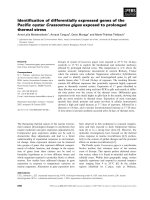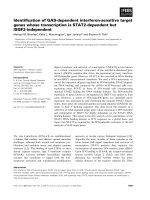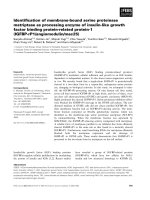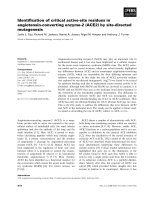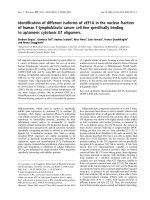Báo cáo khoa học: Identification of yeast aspartyl aminopeptidase gene by purifying and characterizing its product from yeast cells potx
Bạn đang xem bản rút gọn của tài liệu. Xem và tải ngay bản đầy đủ của tài liệu tại đây (2.54 MB, 7 trang )
Identification of yeast aspartyl aminopeptidase gene by
purifying and characterizing its product from yeast cells
Ryo Yokoyama*, Hiroshi Kawasaki and Hisashi Hirano
Supramolecular Biology, International Graduate School of Arts and Sciences, Yokohama City University, Japan
Although sequencing of the yeast genome was comple-
ted several years ago, protein databases still contain
numerous hypothetical proteins that have yet to be
identified in yeast cells. While analyzing the higher-
molecular-mass fraction of yeast proteins, we found
a homo-multimeric complex, the subunit of which
was encoded by the uncharacterized gene, yhr113w.
Sequence analysis of the Yhr113w protein suggested
that it was an aminopeptidase.
Aminopeptidases remove amino acids sequentially
from the unblocked N-termini of peptides and proteins
[1]. Various aminopeptidases with different substrate
specificities are distributed widely in prokaryotes and
eukaryotes [2]. These aminopeptidases are classified
into 19 groups, based on substrate specificity. Most
aminopeptidases are metalloproteases [2], although a
few have been reported to act at serine sites.
The amino-acid sequence of Yhr113wp is similar to
that of human aspartyl aminopeptidase (EC 3.4.11.21)
and yeast vacuole aminopeptidase I (EC 3.4.11.22).
These enzymes belong to the M18 family of metallo-
proteases, each member of which comprises 8–12 iden-
tical subunits that contain zinc ions. However, there is
no general metalloprotease motif for the sequences of
M18 family proteins, such as the HEXXH + E motif
for zinc binding in other aminopeptidases. Little is
known about the active sites of M18 family proteins.
We purified the protein complex of Yhr113wp from
yeast cells and identified it as yeast aspartyl amino-
peptidase on the basis of its enzymatic activity. Aspar-
tyl aminopeptidase has been reported to be present in
mammals, but the enzyme has not previously been
purified from other organisms such as plants, fungi,
and bacteria, although it has been suggested, on the
basis of sequence similarity, that aspartyl aminopeptid-
ases are widely distributed. Here, we confirm that the
enzyme with aspartyl aminopeptidase activity is widely
distributed in eukaryotes.
Keywords
aspartyl aminopeptidase; evolution; M18
family of metalloproteases; matrix-assisted
laser desorption ionization time-of-flight
mass spectrometry
Correspondence
Dr. Hiroshi Kawasaki, Yokohama City
University, Maioko-cho 641-12, Totsuka-ku,
Yokohama, Kanagawa, 244-0813, Japan
E-mail:
*Present address
Laboratory for Immunogenomics, Research
Center for Allergy and Immunology, Institute
of Physical and Chemical Research, 1-7-22
Suehiro, Tsurumi, Yokohama 230-0045,
Japan
(Received 8 September 2005, revised 6
November 2005, accepted 9 November
2005)
doi:10.1111/j.1742-4658.2005.05057.x
Aspartyl aminopeptidase (EC 3.4.11.21) cleaves only unblocked N-terminal
acidic amino-acid residues. To date, it has been found only in mammals.
We report here that aspartyl aminopeptidase activity is present in yeast.
Yeast aminopeptidase is encoded by an uncharacterized gene in chromo-
some VIII (
1
YHR113W, Saccharomyces Genome Database). Yeast aspartyl
aminopeptidase preferentially cleaved the unblocked N-terminal acidic
amino-acid residue of peptides; the optimum pH for this activity was
within the neutral range. The metalloproteases inhibitors EDTA and 1.10-
phenanthroline both inhibited the activity of the enzyme, whereas bestatin,
an inhibitor of most aminopeptidases, did not affect enzyme activity. Gel
filtration chromatography revealed that the molecular mass of the native
form of yeast aspartyl aminopeptidase is 680 000. SDS ⁄ PAGE of purified
yeast aspartyl aminopeptidase produced a single 56-kDa band, indicating
that this enzyme comprises 12 identical subunits.
192 FEBS Journal 273 (2006) 192–198 ª 2005 The Authors Journal compilation ª 2005 FEBS
Results
Purification of yeast aspartyl aminopeptidase
A novel aspartyl aminopeptidase was purified from
yeast cells by ultracentrifugation, ammonium sulfate
fractionation, and chromatography. Mono Q chroma-
tography was used to separate aspartyl aminopepti-
dase activity into three major peaks (Fig. 1). The
first and second peaks were pooled as fraction I and
II, respectively, and proteins within each fraction
were separated by Superose 6 gel chromatography
(Fig. 2A). Because the third peak exhibited leucyl
aminopeptidase activity, proteins in this peak were
not purified further. The aspartyl aminopeptidase
activity was eluted from the Superose 6 column as a
high-molecular-mass complex for both fractions I
and II. SDS ⁄ PAGE revealed that the active fractions
from fraction I contained a protein with a molecular
mass of 56 kDa (Fig. 2B). This 56-kDa protein was
identified as Yhr113wp by peptide mass fingerprint-
ing using MALDI-TOF MS. Fractions from fraction
II were pooled and separated further on a Supe-
rose 6 column. The active fraction from fraction II
Fig. 1. Purification of yeast aspartyl aminopeptidase by Mono Q
anion-exchange chromatography. Three peaks were associated with
aspartyl aminopeptidase activity. The third peak exhibited leucine
aminopeptidase activity. Fractions I (solid line; Fr. 10–11) and II
(dotted line; Fr. 14) were pooled before being applied to a Supe-
rose 6 column. Leucine aminopeptidase activity (s) was measured
using a fluorogenic substrate. Aspartyl aminopeptidase activity (d)
was measured using MALDI-TOF MS.
A
B
C
Fig. 2. Separation of yeast aspartyl aminopeptidase by chromato-
graphy. (A) Elution of the activity in Mono Q fractions I and II using
a Superose 6 column. (s, d) Activity of fractions I and II, respect-
ively. (B, C) Results of SDS ⁄ PAGE analysis of fractions I and II.
Lane numbers correspond to the chromatography fractions. Lane
M contained a molecular mass marker. Arrows indicate the position
of yeast aspartyl aminopeptidase.
R. Yokoyama et al. Yeast aspartyl aminopeptidase
FEBS Journal 273 (2006) 192–198 ª 2005 The Authors Journal compilation ª 2005 FEBS 193
was eluted at the same position as that from fraction
I (Fig. 2A). The active fractions from fraction II,
however, contained two polypeptides with molecular
masses of 31 and 24 kDa (Fig. 2C). Both of these
peptides were identified as Yhr113wp by peptide
mass finger printing. These results indicate that the
polypeptides in the Yhr113wp complex were cleaved
by proteases without loss of aspartyl aminopeptidase
activity.
We purified 400 ng yeast aspartyl aminopeptidase
(uncleaved form) from fraction I (Fig. 3), which was
used for the following experiments.
Yeast aspartyl aminopeptidase activity
We analyzed the initial degradation velocity of various
concentrations of angiotensin I by yeast aspartyl ami-
nopeptidase. The degradation reaction constant (K
m
)
was estimated to be 0.064 mm based on a Lineweaver–
Burk plot.
Molecular mass of the native yeast aspartyl
aminopeptidase complex
FPLC revealed that the molecular mass of the native
yeast aspartyl aminopeptidase was 680 kDa. Because
the molecular mass of Yhr113wp obtained using
SDS ⁄ PAGE was 56 kDa, and the molecular mass of
Yhr113wp calculated from the amino-acid sequence
was 54.2 kDa, we deduced that the aspartyl amino-
peptidase complex comprises 12 subunits.
Aminopeptidase digestion of peptide substrates
The purified yeast aspartyl aminopeptidase did not
digest Leu-NH-Mec, Ala-NH-Mec, Met-NH-Mec,
Phe-NH-Mec, or Lys-NH-Mec (data not shown).
Yeast aspartyl aminopeptidase cleaved the unblocked
N-terminal acidic amino-acid residue of several differ-
ent peptides (Table 1), but failed to cleave N-acetylat-
ed Asp, Tyr, Ile, and Sar (sarcosine) residues at the
N-terminus. The N-terminal Asn residue of peptide
was cleaved after prolonged incubation. Although
yeast aspartyl aminopeptidase cleaved the first N-ter-
minal acidic amino-acid residue of peptides, it did not
cleave the second N-terminal Gly or Arg residue.
These results suggest that it only exhibits substrate
specificity for unblocked N-terminal acidic amino-acid
residues. This characteristic is shared by mammalian
aspartyl aminopeptidases. Comparison of the digestion
Table 1. Activities of purified yeast aspartyl aminopeptidase against various peptide substrates. The values are mean ± SD from four inde-
pendent experiments.
Substrate Sequence Activity (%)
Angiotensin I Asp-Arg-Val-Tyr-Ile-His-Pro-Phe-His-Leu 100
Angiotensin II Asp-Arg-Val-Tyr-Ile-His-Pro-Phe 144 ± 5.7
Angiotensinogen 1–14 Asp-Arg-Val-Tyr-Ile-His-Pro-Phe-His-Leu-Leu-Val-Tyr-Ser 35 ± 6.4
Angiotensin II antipeptide Glu-Gly-Val-Thr-Val-His-Pro-Val 116 ± 2.9
N-Acetyl-angiotensinogen 1–14 Ac-Asp-Arg-Val-Tyr-Ile-His-Pro-Phe-His-Leu-Leu-Val-Tyr-Ser 0
Tyr-bradykinin Tyr-Arg-Pro-Pro-Gly-Phe-Ser-Pro-Phe-Arg 0
Ile-Ser-bradykinin Ile-Ser-Arg-Pro-Pro-Gly-Phe-Ser-Pro-Phe-Arg 0
[Sar1,Ala8]Angiotensin II Sar-Arg-Val-Tyr-Ile-His-Pro-Ala 0
Fig. 3. Yeast aspartyl aminopeptidase (uncleaved form). The
enzyme was purified from Mono Q fraction I. Lane 1 shows the
purified enzyme stained with silver. Lane M contained a molecular
mass marker.
Yeast aspartyl aminopeptidase R. Yokoyama et al.
194 FEBS Journal 273 (2006) 192–198 ª 2005 The Authors Journal compilation ª 2005 FEBS
of angiotensin I and II and angiotensinogen 1–14 by
yeast aspartyl aminopeptidase revealed that the enzyme
cleaved the shorter peptides at a higher rate.
Effect of inhibitors on aspartyl aminopeptidase
activity
Table 2 shows the effects of various inhibitors on the
activity of yeast aspartyl aminopeptidase. EDTA and
1,10-phenanthroline, which are metalloprotease inhibi-
tors, caused inhibition. In contrast, bestatin, an inhib-
itor of most aminopeptidases, did not affect the
activity of yeast aspartyl aminopeptidase.
Discussion
We purified a novel aspartyl aminopeptidase from yeast
and identified it as Yhr113wp. It cleaved only the
unblocked N-terminal acidic amino acid of peptides.
The enzyme did not cleave N-terminal neutral and basic
amino-acid residues. The s ubstrate specificity a nd opti-
mum pH (7.5–7.9; data not shown) were s imilar to those
for mammalian aspartyl aminopeptidase extracted from
the c ytosol of rabbit brain cells [3]. However, there ar e
several d ifferences between the mammalian and yeast
enzymes. First, t he subunit composition d iffers. Mam-
malian aspartyl aminopeptidases comprise eight identical
subunits, whereas the yeast enzyme contains 12 identical
subunits. Second, the m ammalian aspartyl amin opepti-
dase has been repor ted not to be affected by EDTA,
whereas yeast aspartyl aminopeptida se was inhibited by
EDTA in this study. This indicates t hat the surround-
ings of the zinc ion in yeast aspartyl aminopeptidase dif-
fer from those of the mammalian enzyme. The yeast
enzyme was not affected b y bestatin, an inhibitor of
most aminopeptidases. Wilk et al. [3] reported that the
mammalian enzyme wa s also unaffected by bestatin.
Yeast aminopeptidase I and aspartyl aminopepti-
dase, both of which belong to the M18 family of metal-
loprotease, comprise 12 identical subunits, and the
activity of these enzymes is inhibited by EDTA [4,5].
These two enzymes may be related evolutionarily. The
substrate specificity of aminopeptidase I is different
from that of yeast aspartyl aminopeptidase, aminopept-
idase I preferentially cleaving hydrophobic N-terminal
amino-acid residues. The M18 family has so far been
found to contain 55 proteins (sequences) from bacteria
and eukaryotes [6]. We selected 12 of these and aligned
their sequences using the clustal_x program [7]
(Table 3). This revealed three conserved His residues,
two conserved Glu residues, and five conserved Asp
residues. As His, Cys, Glu, and Asp are often ligands
for zinc ions [8], the aforementioned conserved amino-
acid residues may be related to active and zinc-binding
enzyme sites, as reported by Wilk et al. [3,9]. The
dendrogram of proteins similar to Yhr113wp suggests
that these proteins can be divided into two groups
(Fig. 4). Yeast and mammalian aspartyl aminopepti-
dase have the same specificity, and these aminopeptid-
ases lie within the same group of the dendrogram.
Proteins in this group, such as those from Schizosac-
charomyces pombe, Caenorhabditis elegans and Arabid-
opsis thaliana, should exhibit aspartyl aminopeptidase
activity. These results suggest that aspartyl aminopep-
tidases are present in several eukaryotes. Basic amino
acids were conserved at several sites of the aspartyl
aminopeptidases. One site, indicated by ‘B’ in Table 3,
was conserved only in aspartyl aminopeptidases and
not other members of the M18 family. This site may
determine the substrate specificity of the enzyme.
As aspartyl aminopeptidases lack the N-terminal
signal sequence present in the aminopeptidase I pre-
cursor, they are probably located in the cytosol. There-
fore, aspartyl aminopeptidase activity may be related
to the metabolism of cytosolic peptides, particularly
during the final step in their degradation. Tamura
et al. [10] reported that three aminopeptidases
are involved in the final degradation of proteins in
Thermoplasma acidophilum, one of which preferentially
cleaves the N-terminal acidic amino-acid residues of
short peptides. In the present study, yeast aspartyl
aminopeptidase preferentially cleaved shorter peptides.
Therefore, yeast aspartyl aminopeptidase may partici-
pate in the final step of protein degradation.
In conclusion, we have investigated the biochemical
properties of yeast aspartyl aminopeptidase, which is
the product of an uncharacterized gene, yhr113w. Our
findings suggest that it may be involved in protein
catabolism in the cytosol of yeast cells.
Experimental procedures
Materials
The yeast strain used was B-8032 (MATa ura3-52 CYC1-
963 cyc7-67 lys5-10). Leupeptin, bestatin, and TPCK-tryp-
Table 2. Effect of inhibitors on aspartyl aminopeptidase activity.
Inhibitor Activity (%)
None 100
Bestatin (0.2 m
M) 99.3 ± 16
EDTA (20 m
M) 23.9 ± 4.2
1,10-Phenanthroline (5 m
M) 66.5 ± 4.5
Enzyme activity was measured with the substrate angiotensin I.
Each treatment was repeated three times.
R. Yokoyama et al. Yeast aspartyl aminopeptidase
FEBS Journal 273 (2006) 192–198 ª 2005 The Authors Journal compilation ª 2005 FEBS 195
Table 3. Alignment of amino-acid sequence of aminopeptidases in M18 family. The sequences, Saccharomyces cerevisiae (Yhr113wp)
(P38821), S. pombe (036014), Homo sapiens (Q9ULA0), Mus musculs (Q9Z2W0), C. elegans (Q19087), A. thlaliana (Q9LST0), Pseudomonas
aeruginosa (Q9HYZ3), Mycobacterium leprae
2
(Q50022), Streptomyces coelicolor (Q9XA76), Borrelia burgdorferi
2,3
(O51572), S. cerevisiae (Lap4p)
(P14904), and Thermotoga neapolitana (O86957) are aligned using
CLUSTAL_X. Amino acids identical in at least 10 of 12 sequences are shaded,
and histidines, glutamates, and aspartates conserved among all sequences are indicated with *. The sites of basic amino acids conserved
among all of the aspartyl aminopeptidases are indicated with b or B. The site of B, which is near the putative active site of glutamate, may deter-
mine the substrate specificity of the enzyme.
Yeast aspartyl aminopeptidase R. Yokoyama et al.
196 FEBS Journal 273 (2006) 192–198 ª 2005 The Authors Journal compilation ª 2005 FEBS
sin were from Sigma (St Louis, MO, USA). We used the
following peptides (obtained from Sigma) as substrates: an-
giotensin I (DRVYIHPFHL); angiotensin II (DRVYIHPF);
[Asn1,Val5]angiotensin II (NRVYVHPF); angiotensin II
antipeptide (EGVTVHPV); [Sar1,Ala8]angiotensin II (sarc-
osyl-RVYIHPA); angiotensinogen 1–14 (DRVYIHPFHLL
VYS); N-acetyl-angiotensinogen 1–14 (Ac-DRVYIHPFH
LLVYS); Tyr-bradykinin (YRPPGFSPFR); and Ile-Ser-
bradykinin (ISRPPGFSPFR). NH-Mec substrates were
obtained from the Peptide Institute (Osaka, Japan). a-Cy-
ano-4-hydroxycinnamic acid was purchased from Aldrich
(Milwaukee, WI, USA).
Measurement of aspartyl aminopeptidase activity
Aspartyl aminopeptidase activity was measured using an-
giotensin I as substrate. The enzyme was mixed with a
solution of 50 lm angiotensin I and the reaction solution
was incubated at 37 °C for various time periods. The
reaction was stopped by the addition of acetic acid, and
the reaction solution was then diluted with water to
reduce the concentrations of salts. The digested peptide
substrate was analyzed using MALDI-TOF MS. The
amount of peptide generated was estimated from the
ratio of the height of the product peptide peak versus
the sum of the heights of the product peptide and sub-
strate peaks.
Purification of yeast aspartyl aminopeptidase
Yeast cells were grown in YPD medium (10 gÆL
)1
yeast
extract, 20 gÆL
)1
bactopeptone, and 20 gÆL
)1
glucose) at
29 °C for 72 h with continuous shaking at 160 r.p.m. Cells
were then harvested by centrifugation at 2000 g for 10 min.
Cell extracts were prepared by vortex-mixing a suspension
of cells (50%, v ⁄ v) with glass beads (0.45 mm) in 50 mm
Tris ⁄ HCl (pH 7.5) ⁄ 10% (v ⁄ v) glycerol ⁄ 2 l gÆmL
)1
leupeptin
(buffer A) on ice. The beads and unbroken cells were
removed by centrifugation at 8000 g for 20 min. Micro-
somes and organelles were removed by two successive
centrifugations at 40 000 g for 40 min and 66 000 g for
50 min. Thereafter, high-molecular-mass proteins were pre-
cipitated by ultracentrifugation at 200 000 g for 5 h. The
precipitate was dissolved in buffer A and proteins were
fractionated with ammonium sulfate (40–80% saturation).
The precipitate was collected by centrifugation (15 000 g,
15 min) and dissolved in 50 mm Tris ⁄ HCl buffer (pH 7.5)
containing 10% glycerol and 0.2 m KCl (buffer B). The
solution was passed through a Bio-Gel A-1.5m column
(2.5 cm internal diameter · 40 cm; Bio-Rad, Hercules, CA,
USA) equilibrated with buffer B. The aspartyl aminopepti-
dase activity of each fraction was measured. The active
fractions were pooled and dialyzed against 25 mm
Tris ⁄ HCl, pH 7.5 (buffer C). The sample solution was
applied to a Mono Q FPLC column (0.5 cm internal diam-
eter · 5 cm; Amersham Bioscience, Uppsala, Sweden) equil-
ibrated with buffer C. After the column had been washed
with buffer C (3 · column volume), the enzyme was eluted
with a linear gradient (0–0.5 m) of KCl in buffer C. The
activities of aspartyl aminopeptidase and leucyl aminopepti-
dase were measured for each fraction. Fractions that exhib-
ited aspartyl aminopeptidase activity were pooled, and
proteins in the combined fractions were precipitated with
80% saturated ammonium sulfate. The precipitate was col-
lected by centrifugation at 15 000 g for 30 min and dis-
solved in 50 mm Tris ⁄ HCl (pH 7.5) ⁄ 0.2 m KCl (buffer D).
The solution was passed through a Superose 6 column
(1.0 cm internal diameter · 30 cm; Amersham Bioscience)
equilibrated with buffer D. Fractions that contained
Yhr113wp were stored at )30 °C. Each fraction was ana-
lyzed by SDS ⁄ PAGE using 15% gels by the methods of
Hirano [11]. Yhr113wp was identified by peptide mass
finger printing using MALDI-TOF MS.
In-gel digestion and peptide mass fingerprinting
The protein band on each SDS ⁄ polyacrylamide gel was
cut into small pieces which were incubated in 50% (v ⁄ v)
acetonitrile, 0.1% (v ⁄ v) trifluoroacetic acid, and 0.5%
(v ⁄ v) N-ethylmaleimide at 37 °C for 1 h to remove Coo-
massie Brilliant Blue. Thereafter, the gel pieces were
washed with water before 5 lL 0.3 m N-ethylmaleimide
(pH 8.2) and 1 lL 140 mm 2-mercaptoethanol were added.
After a 30-min incubation at 37 °C, 1 lL TPCK-trypsin
(50 lgÆmL
)1
) was added for 16 h at 37 °C to digest the
protein. Peptide mass fingerprinting was carried out using
MALDI-TOF MS (Tof Spec 2E; Micromass, Manchester,
UK). The matrix solution was 60% (v ⁄ v) acetonitrile sat-
urated with a-cyano-4-hydroxy-trans-cinnamic acid. Pep-
tides produced by in-gel digestion were concentrated with
ZipTipC
18
(Millipore, Bedford, MA, USA). The peptide
Fig. 4. Dendrogram of the M18 family of metalloproteases. The
dendrogram was constructed from the alignments shown in
Table 3.
R. Yokoyama et al. Yeast aspartyl aminopeptidase
FEBS Journal 273 (2006) 192–198 ª 2005 The Authors Journal compilation ª 2005 FEBS 197
and matrix solution (1 lL each) were mixed on a target
plate.
Measurement of aminopeptidase activity
Activities of various aminopeptidases were measured using
Leu-NH-Mec, Phe-NH-Mec, Met-NH-Mec, Ala-NH-Mec,
and Lys-NH-Mec (0.1 mm) as substrates. Fluorescence
of 7-methylcoumarin released as the result of enzymatic
activity was measured at an excitation ⁄ emission wavelength
of 390 ⁄ 460 nm using a Labsystems Fluoroskan II (Dainip-
pon Pharmaceutical, Suita, Japan).
Purified yeast aspartyl aminopeptidase and various pep-
tide substrates (50 lm each) were mixed and incubated at
37 °C. Activity with the various peptides was measured by
the method used to measure aspartyl aminopeptidase activ-
ity with angiotensin I.
Determination of molecular mass of native yeast
aspartyl aminopeptidase
The molecular mass of the native yeast aspartyl aminopept-
idase was determined by FPLC using a Superose 6 column.
The purified enzyme and a standard marker for gel filtra-
tion (Bio-Rad) and ferritin (Sigma) were mixed before
being separated on a Superose 6 column equilibrated with
buffer D. The molecular mass was calculated by comparing
the position of the absorbance peak (280 nm) of the stand-
ard marker with that of aspartyl aminopeptidase.
Effect of inhibitors on aspartyl aminopeptidase
activity
Solutions of various inhibitors of enzymatic activity were
mixed with yeast aspartyl aminopeptidase and incubated at
37 °C for 15 min. Enzyme activity was measured at 37 °C
for 10 min using 50 l m angiotensin I as substrate.
References
1 Taylor A (1993) Aminopeptidases: structure and func-
tion. FASEB J 7, 290–298.
2 Rawlings ND & Barrett AJ (1995) Evolutionary families
of metallopeptidases. Methods Enzymol 248, 183–228.
3 Wilk S, Wilk E & Magnusson RP (1998) Purification,
characterization, and cloning of a cytosolic aspartyl
aminopeptidase. J Biol Chem 273 , 15961–15970.
4 Frey J & Rohm KH (1978) Subcellular localization and
levels of aminopeptidases and dipeptidase in Saccharo-
myces cerevisiae . Biochim Biophys Acta 527, 31–41.
5 Metz G & Rohm KH (1976) Yeast aminopeptidase I.
Chemical composition and catalytic properties. Biochim
Biophys Acta 429, 933–949.
6 Rawlings ND, Tolle DP & Barrett AJ (2004) MEROPS:
the peptidase database. Nucleic Acids Res 32, D160–
D164.
7 Thompson JD, Gibson TJ, Plewniak F, Jeanmougin F
& Higgins DG (1997) The CLUSTAL_X windows inter-
face: flexible strategies for multiple sequence alignment
aided by quality analysis tools. Nucleic Acids Res 25,
4876–4882.
8 Vallee BL & Auld DS (1990) Zinc coordination, func-
tion, and structure of zinc enzymes and other proteins.
Biochemistry 29 , 5647–5659.
9 Wilk S, Wilk E & Magnusson RP (2002) Identification
of histidine residues important in the catalysis and
structure of aspartyl aminopeptidase. Arch Biochem
Biophys 407, 176–183.
10 Tamura N, Lottspeich F, Baumeister W & Tamura T
(1998) The role of tricorn protease and its aminopepti-
dase-interacting factors in cellular protein degradation.
Cell 95, 637–648.
11 Hirano H (1989) Microsequence analysis of winged
bean seed proteins electroblotted from two-dimensional
gel. J Protein Chem 8, 115–130.
Yeast aspartyl aminopeptidase R. Yokoyama et al.
198 FEBS Journal 273 (2006) 192–198 ª 2005 The Authors Journal compilation ª 2005 FEBS


